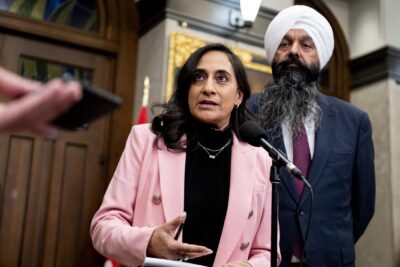Global Affairs Canada could merge embassies with allies, must focus on trade: budget
By Canadian Press on November 4, 2025.

OTTAWA — The Carney government’s first budget redirects diplomatic dollars to the trade file while cutting Global Affairs Canada’s budget — possibly by merging some embassies with those operated by like-minded countries.
In addition to $2.7 billion in cuts to foreign aid, Tuesday’s budget calls for Canada to refocus its international presence when it comes to advocacy, security and development, while boosting exports to priority economies.
Global Affairs Canada’s planned spending for the current fiscal year was $8.1 billion. Tuesday’s budget forecasts $561 million in cuts in the next fiscal year, scaling up to $1.1 billion in annual savings two years later, and for each ongoing year.
The budget says the government wants to streamline its Trade Commissioner Service, which currently involves bureaucrats working out of embassies abroad to identify opportunities for Canadian businesses.
The changes would have bureaucrats do more proactive outreach to Canadian CEOs, and launch a “strategic exports office” to make that work more effective. The office will “build sophisticated, proactive road maps for Canadian senior-level engagement to open doors and remove roadblocks for Canadian companies,” the budget document says.
The budget says the new office would work “to remove long-standing trade irritants, market access barriers, infrastructure gaps, and financing needs.”
Ottawa has allocated cash for more trade missions abroad. It’s also looking to expand exports by boosting domestic infrastructure through a Trade Diversification Corridors Fund and a building spree in the Arctic.
The budget document says Ottawa is also looking to tighten trade-support programs “to reduce duplication, lower administrative overhead and focus efforts on high-impact services for Canadian businesses.”
The budget pitches $1.7 billion in new investments to make Canada more competitive in trade.
The budget explicitly links Canada with Asia and Europe — and makes no reference to the Trudeau government’s Africa strategy that sought to expand trade with the booming continent. It also says nothing about the Mercosur bloc; the federal government is looking to sign a trade deal with that group of South American countries.
The document alludes to a “trade diversification strategy” that Trade Minister Maninder Sidhu is expected to release in the coming weeks.
And the government is looking to consolidate its foreign service footprint abroad. That could mean combining trade offices, consulates and even ambassadorial residences into single facilities.
The budget document says that could involve “co-locating some offices with allies where appropriate,” and it could even mean purchasing buildings that Canada has leased abroad.
The budget refers to “acquiring Crown-owned properties in certain cases” but doesn’t specify what the Crown owns abroad.
The budget also mentions “revamping emergency preparedness” and consular services. Bureaucrats warned Foreign Affairs Minister Anita Anand multiple times in her briefing binder this spring that the cost of evacuating Canadians and their foreign relatives from geopolitical hot spots like Haiti and Lebanon has been rising fast.
Anand has said that Canada’s diplomatic focus going forward will be on economic security, continental defence and human rights concerns.
The budget does not say whether Ottawa will fill vacant positions such as the climate change ambassador, the envoy for women, peace and security, and the ombudsperson responsible for investigating reports of forced labour abroad.
The budget also did not say whether Global Affairs Canada will see staffing reductions.
The diplomats’ union, the Professional Association of Foreign Service Officers, had urged the department to look at trimming its spending on consultants and at duplication of internal services, rather than cutting back on Canadians posted abroad.
Former diplomats have also warned that cutting back on diplomats will limit Canada’s influence at a time where adversaries are boosting their soft power and diplomatic outreach, and as the U.S. State Department draws down its diplomatic presence.
This report by The Canadian Press was first published Nov. 4, 2025.
Dylan Robertson, The Canadian Press
25-24

